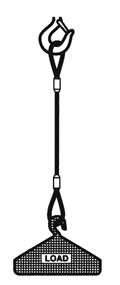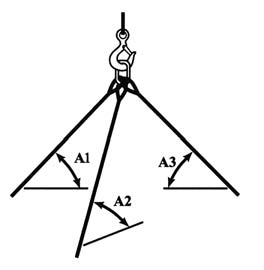
|
|
|



SLINGS
WIRE ROPE
GENERAL INFORMATION
This D/d ratio is applied to wire rope slings to assure that
the strength in the body of the sling is at least equal to the
splice efficiency. When D/d ratios smaller than those listed
in the rated capacity tables are necessary, the rated
3
capacity of the sling must be decreased.
RATED CAPACITY is the maximum static load a sling is
designed to lift. The tables give rated capacities in tons of
2000 pounds. Rated capacities contained in all the tables
were calculated by computer. Each value was calculated
starting with the nominal component rope strength and
working up from there. Due to computer rounding of
Figure 7.
numeric values, rated capacity values for 2, 3 or 4 leg
slings may not be even multiples of single leg values and
PROOF LOAD is a specific load applied o a sling or
may differ by a small amount. This represents the state
assembly in a non destructive test to verify the workman
of the art technology and tables found in other publications
ship of the sling. All swaged socket or poured socket
which differ by this small amount should not be construed
assemblies should be proof loaded. The proof load is gen
to be in error. The difference is generally no more than
erally two (2) times the vertical rated capacity for mechani
one unit for any sling diameter.
cal splice slings. The maximum proof load for hand tucked
slings is 1.25 times the vertical rated capacity. Care
When a wire rope is bent around any sheave or other cir
should be taken to assure that sling eyes are not damaged
cular object, there is a loss of strength due to this bending
during the proof load.
action. As the D/d ratio becomes smaller this loss of
EYE DIMENSIONS are generally eight (8) sling body
diameters wide by sixteen (16) body diameters long.
Whenever possible thimbles are recommended to protect
the rope in the sling eye. Eye dimensions for thimbles are
contained in table 2. Table 2 contains only dimensions for
thimbles used in standard single part slings. Other spe
cialized thimbles are available. Consult your sling manu
facturer for details.
PIN DIAMETER should not be any greater than the natural
width of the sling eye. For any sized eye and type of sling
body, the maximum allowable pin diameter may be calcu
Figure 5.
lated as follows.
strength becomes greater and the rope becomes less effi
Maximum pin diameter = (2L + W) x 0.2
cient. This curve, derived from actual test data, relates the
Where
efficiency of a rope to different D/d ratios. This curve is
L = length of eye
based on static loads only and applies to 6X19 and 6X37
W = width of eye
class ropes.
The minimum pin diameter should never be smaller than
the nominal sling diameter.
GRADE & CONSTRUCTION of wire rope for slings is gen
erally accepted to be bright Improved Plow Steel or Extra
Improved Plow Steel grade 6x19 or 6x37 classification reg
ular lay. IWRC rope has a higher rated capacity than Fiber
Core rope for mechanically spliced slings, but the same
rated capacity for hand tucked slings. This is because
when making a hand tucked splice, the core (IWRC) of the
Figure 6.
39